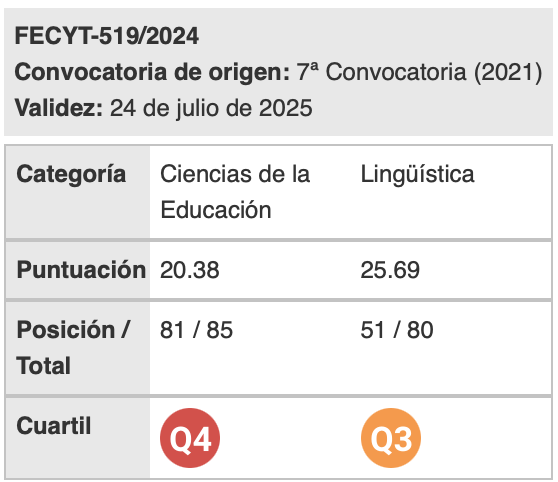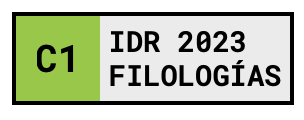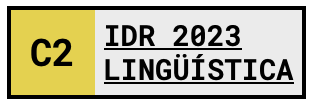Spanish vs. English mediated lectures: A contrastive approach to the use of evidential markers
Keywords:
evidentiality, cross-linguistic influence, source language interference, English mediated education, Tertiary EducationAbstract
In the last ten years, Spanish universities have started to incorporate English as a means of instruction. As a consequence, many lecturers –who regularly use their mother tongue for their teaching activity– have adapted their syllabus contents into English, resulting in lectures that show evidence of cross-linguistic influence (Odlin, 1993). The goal of this paper is to analyze the use and distribution of evidentials in Spanish and English mediated lectures by the same teachers and to evaluate the extent to which linguistic interference is made visible when it comes to the use of evidentiality. To this aim, a corpus of three Engineering lectures delivered in English and three Engineering lectures delivered in Spanish by the same native speakers of Spanish lecturers has been used as a means of exemplification.
Downloads
References
Aikhenvald, A. (2004). Evidentiality. Oxford: Oxford University Press.
Anderson, Lloyd B.(1986). Evidentials, paths of change, and mental maps: Typologically regular asymmetries. In: Wallace Chafe and Johanna Nichols (eds.), Evidentiality: The Linguistic Coding of Epistemology (pp. 273-312). Norwood, NJ: Ablex.
Boye, K. (2010a) Semantic maps and the identification of cross-linguistic generic categories: Evidentiality and its relation to epistemic modality. Linguistic Discovery 8(1): 4-22.
Boye, K. (2010b) Evidence for what? Evidentiality and scope. STUF 63(4): 290-307.
Boye, K. & Harder, P. (2009). Evidentiality. Linguistic categories and grammaticalization. Functions of Language 16(1): 9-43.
Braga-Riera, J., & Maíz, C. (forthcoming). The Role of CLIL Lecturers as Translators. In S. Sebnem and L. Pérez-González (Eds.), Non-professionals Translating and Interpreting: Participatory and Engaged Perspectives. Manchester: St Jerome Publishing.
Bybee, J. (1985). Morphology: A Study of the Relation between Meaning and Form. Amsterdam: John Benjamins.
Cenoz, J., Hufeisen, B., & Jessner, U. (Eds.). (2001). Cross-Linguistic Influence in Third Language Acquisition. Clevedon: Multilingual Matters.
Chafe, W. (1986). Evidentiality in English Conversation and Academic Writing. In: W. Chafe and J. Nichols (Eds.), Evidentiality: The Linguistic Coding of Epistemology (pp. 261-272). New York: Ablex.
Chesterman, A. (1998). Contrastive Functional Analysis. Amsterdam & Philadelphia: John Benjamins.
Crystal, D. (1991). How language breaks down. English Today, 7(1), 21-28
De Haan, F. (2001). The Relation Between Modality and Evidentiality. In Müller, R. & Reis, M. (Eds.), Modälitat und Modalverben im Deutschem (pp. 201-217). Helmut Buske Verlag: Hamburg.
Kellerman, E. (1995). Crosslinguistic Influence: Transfer to Nowhere. Annual Review of Applied Linguistics, 15, 125-150.
Odlin, T. (1993). Language Transfer: Cross-linguistic Influence in Language Learning. Cambridge: Cambridge University Press.
Squartini, M.(2008). Lexical vs. Grammatical Evidentiality in French and Italian. Linguistics, 46, 917-947.
Willett, T. (1988). A Cross-linguistic Survey of the Grammaticalization of Evidentiality. Studies in Language 12, 51-97.
Young, L. (1994). University Lecturers – Macro-structure and Micro-features. In J. Flowerdew (Ed.), Academic Listening: Research Perspectives (pp. 159-176). Cambridge: Cambridge University Press.
Downloads
Published
How to Cite
Issue
Section
License
Authors who publish with this journal agree to the following terms:
- Authors retain copyright and grant the journal right of first publication with the work simultaneously licensed under a Creative Commons Attribution License that allows others to share the work with an acknowledgement of the work's authorship and initial publication in this journal.
- Authors are able to enter into separate, additional contractual arrangements for the non-exclusive distribution of the journal's published version of the work (e.g., post it to an institutional repository or publish it in a book), with an acknowledgement of its initial publication in this journal.
- Authors are permitted and encouraged to post their work online (e.g., in institutional repositories or on their website) prior to and during the submission process, as it can lead to productive exchanges, as well as earlier and greater citation of published work (See The Effect of Open Access).

Revista de Lenguas para fines específicos is licensed under a Creative Commons Reconocimiento-NoComercial-SinObraDerivada 4.0 Internacional License.
























